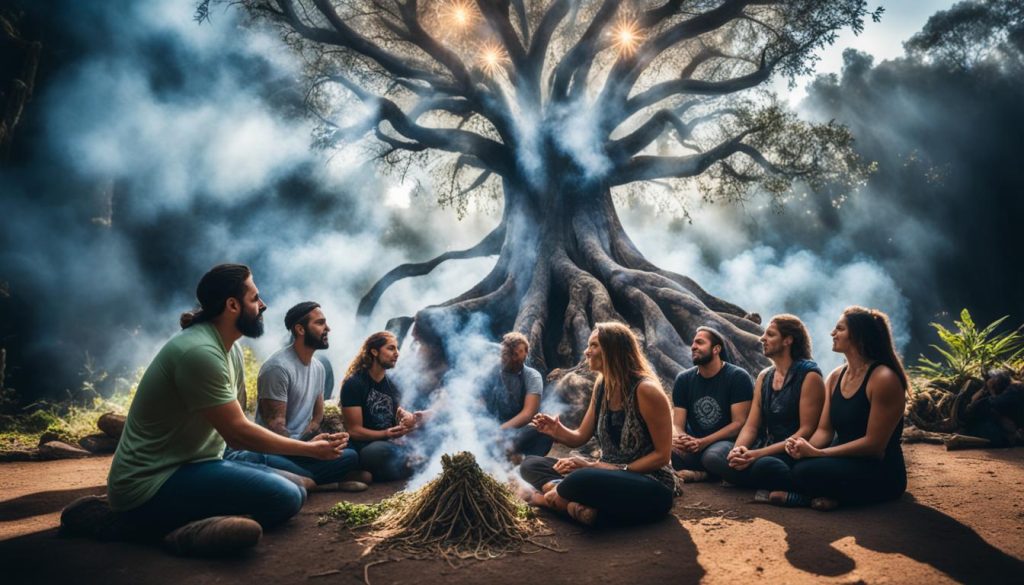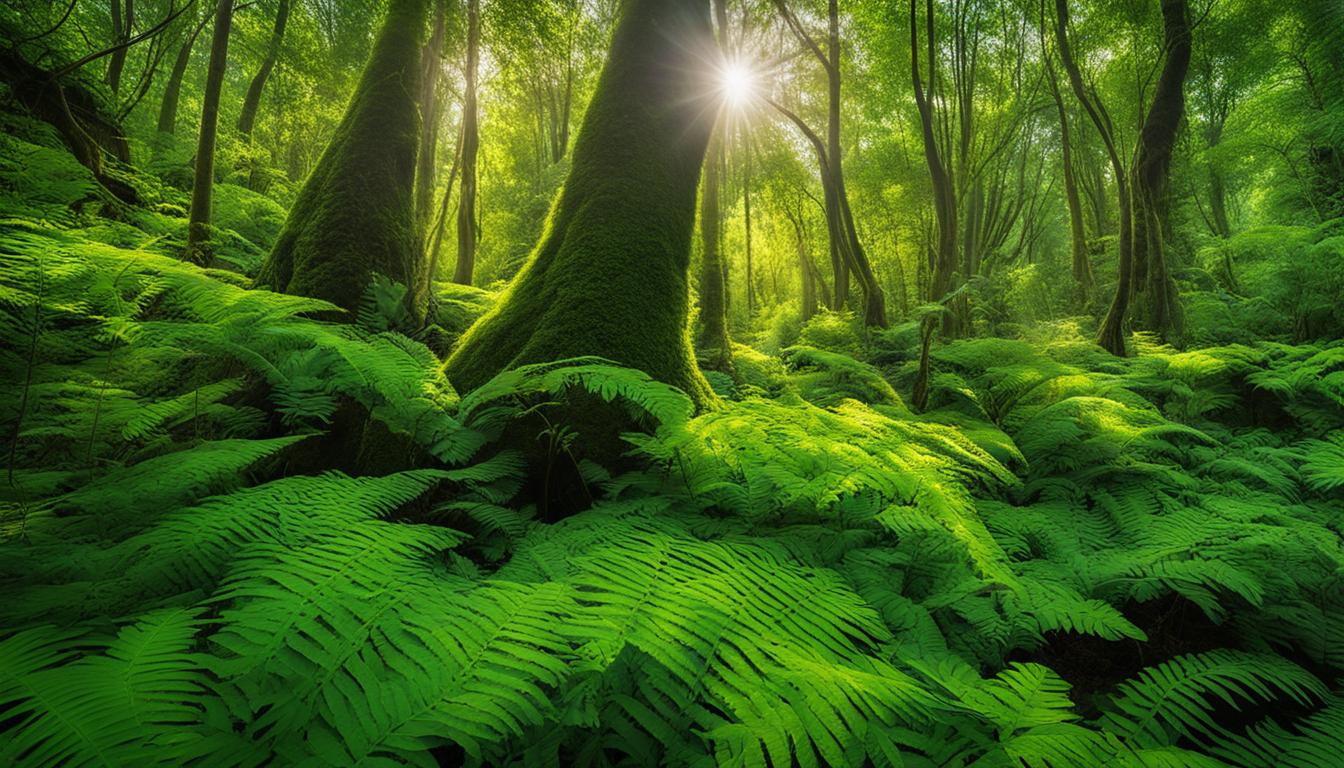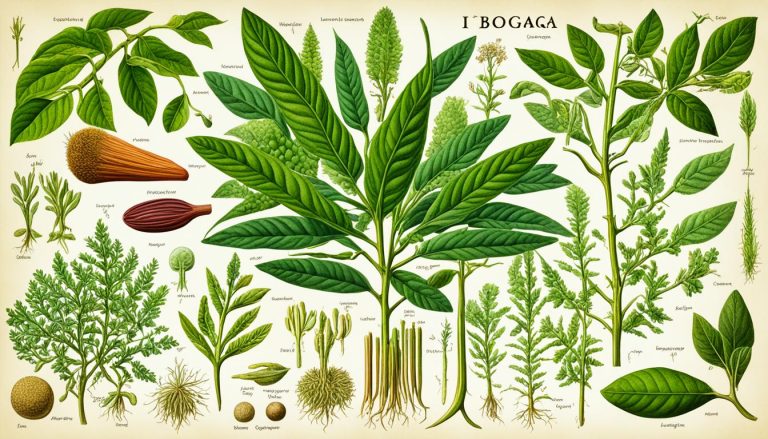What Plant Does Ibogaine Come From?
The quest to understand the properties and uses of ibogaine leads us to the heart of a lush, tropical treasure: the Tabernanthe iboga plant. This remarkable shrub, rooted deep in the undergrowth of Central-West Africa, has fascinated the world with its potent psychoactive abilities. As a natural source of ibogaine, Tabernanthe iboga is not just a botanical specimen; it’s a key to unlocking age-old mysteries of medicine and culture.
The plant origins of ibogaine are as intriguing as the compound itself. The iboga plant’s history weaves through the fabric of African societies, serving as a pivotal element in religious, therapeutic, and community rituals. Now, this natural alkaloid draws the scientific community’s attention for its unique potential in addiction therapy and beyond. Let’s delve into the verdant world of the iboga plant and unearth the secrets it holds within its fibrous roots.
Key Takeaways
- Tabernanthe iboga is the indigenous African shrub that serves as the ibogaine plant source.
- The psychoactive compound ibogaine is extracted from the iboga plant’s root bark, highlighting its significance as a natural source of ibogaine.
- Traditionally, Tabernanthe iboga played a vital role in ceremonial practices, particularly in Bwiti culture, emphasizing the profound cultural and spiritual value of the plant.
- The potential medical properties of ibogaine are sparking new research, thus increasing interest in the iboga plant.
- Understanding the plant origins of ibogaine is instrumental in appreciating its medicinal value and its place in African heritage.
Understanding Ibogaine and Its Plant Origins
Delving into the history of ibogaine, we uncover a past deeply entwined with the traditional uses and ceremonious reverence of the iboga tree. This journey into ibogaine’s storied legacy reveals its influential roles in society and medicine, stretching back over a century.
Discovery and Historical Use of Ibogaine
The enigmatic iboga plant gained the attention of the Western world when French scientists, fascinated by reports of its use in African cultural rituals, succeeded in isolating the indole alkaloid ibogaine from its roots. Since these initial experiments in the early 1900s, the focus on ibogaine as a unique substance with potential therapeutic applications has steadily grown, albeit with a complex path towards acceptance.
Tabernanthe iboga: The Natural Source of Ibogaine
The natural habitat of the ibogaine plant species, Tabernanthe iboga, spans the rich rainforests of Central Africa. The plant’s classification dates back over 140 years, with a history that saw it transported to France for exhibition in the 1860s. Despite its early introduction to the European continent, the realization of ibogaine’s full potential unfolded slowly over the following decades.
Cultural Significance of the Iboga Plant
In the heart of Gabon and Congo, the sap of the iboga tree flows through the veins of spiritual and healing traditions. The Bwiti tribe, in particular, regards the plant as a sacred facilitator for initiation rites, allowing members to transcend the physical plane and interact with the spiritual world. Partaking in the ingestion of iboga signifies a profound right of passage that is integral to their community and identity, underscoring the cultural significance of the iboga plant.

The history of this remarkable plant species and its psychoactive alkaloid tells a tale that transcends science and enters the realm of the spiritual, reminding us of the intricate tapestry of human culture and the natural world.
What Plant Does Ibogaine Come From?
When exploring the natural source of ibogaine, one distinctive shrub from Central-West Africa always comes to light: the Tabernanthe iboga. Known for its deeply ingrained presence in traditional medicine and contemporary addiction therapy, the iboga plant stands out as the exclusive provider of ibogaine, the sought-after alkaloid with potent psychoactive abilities. Curiosity about its origins leads us straight to the dense, lush rainforests where Tabernanthe iboga thrives, entrenched in the cultural fabric of the local communities.
Researchers and scientists remain captivated by this plant, not only due to its therapeutic potential but also because of its unique properties and composition. The roots of the iboga plant, in particular, are rich in ibogaine—a compound that has stirred significant interest for its application in interrupting various forms of substance addiction. This natural source of ibogaine is intricately linked with traditional healing ceremonies, underscoring a bridge between age-old customs and modern medical practices.
As a cornerstone of traditional practices and a beacon of hope in addiction treatment, Tabernanthe iboga rises as a key figure in both ancestral heritage and scientific progression.
Extraction and Synthesis of Ibogaine
The quest to understand and harness the pharmacological effects of ibogaine begins with its extraction from the root bark of the Tabernanthe iboga plant. Cultures in Africa have, for ages, mastered the traditional iboga extraction methods imbued with ritualistic significance. Yet, the scientific community has taken this a step further by developing modern extraction techniques to isolate this intriguing compound with far-reaching therapeutic potential.
Traditional Extraction Methods from Tabernanthe iboga
Traditional iboga extraction is more than a mere process; it’s a cultural heritage, painstakingly preserving the potent alkaloids that contribute to the distinct ibogaine chemical structure. This time-honored practice involves finely shredding the root bark and employing various indigenous methods to extract the alkaloid, a practice deeply rooted in the annals of African ethnomedicine.
Modern Techniques in Isolating Ibogaine
As technology advances, so do the methods of extracting complex compounds. The ibogaine isolation process today typically involves solvent-based extraction protocols that ensure the alkaloid is not only retrieved from the botanical matrix efficiently but also meets the purity requirements for medical research standards.
The Total Synthesis of Ibogaine and Its Derivatives
The synthesis of ibogaine represents a monumental leap forward in its study. Through clever manipulation of molecules in a lab setting, scientists have been able to replicate the ibogaine chemical structure and even spearhead the ibogaine derivatives development. This synthetic milestone is pivotal for creating analogs such as 18-MC, which could broaden the realm of addiction therapy, steering clear of the psychedelic pathways.
In these multifaceted approaches to the ibogaine plant extraction and synthesis, we observe a delicate balance between ancient wisdom and innovative science. The intricate dance to extract, refine, and reinvent this molecule could be the key to unlocking new chapters in the pharmacopeia of the future.
Ibogaine’s Role in Medicine and Research
The burgeoning field of ibogaine research is paving new avenues for confronting addiction. Varied studies elucidate how this substance bridges traditional medicine and modern therapeutic approaches, shining a light on ibogaine’s antiaddictive properties. Given ibogaine’s intricate interactions within the human brain, understanding its role could revolutionize the way we approach addiction treatment.
Contemporary Research on Ibogaine for Addiction Treatment
In the quest to combat addiction, contemporary ibogaine research has yielded promising results. Scientists and medical professionals are meticulously analyzing how ibogaine therapy may offer reprieve to those grappling with substance dependencies. Single doses of ibogaine have demonstrated proficiency in assuaging withdrawal symptoms and dampening the urge for drugs such as opioids and nicotine, signifying its potential as a groundbreaking treatment in the sphere of addiction medicine.
Investigating the Pharmacological Effects of Ibogaine
The pharmacological effects of ibogaine are complex and compelling. As a non-competitive antagonist at NMDA receptors and an influencer of serotonin and dopamine levels, ibogaine exhibits a myriad of actions on neurotransmitters. This multifaceted interaction within the brain sparks significant interest, fueling investigations into its potential to both alleviate addiction and impart profound psychological experiences. Such research endeavors strive to unlock the full scope of ibogaine’s therapeutic capabilities.
Legal Status and Accessibility of Ibogaine Worldwide
The ibogaine legal status is a patchwork of regulations varying drastically from country to country, influencing both the ibogaine accessibility and the expansiveness of ongoing research. In countries where legal ibogaine therapy exists, such as Mexico and Brazil, there is greater latitude for exploring and employing ibogaine in medical contexts. Meanwhile, in the United States, its classification as a Schedule I substance erects formidable barriers to clinical research and widespread adoption of ibogaine therapy, despite its potential benefits. The future of ibogaine in medical practice remains tethered to legal and regulatory frameworks across the globe.
Conclusion
The narrative of ibogaine, stretching from its origins within the verdant rainforests of Central-West Africa to its scrutinized presence in medicinal research facilities, tells a tale of potential and caution. The ceremonial and cultural journey of ibogaine provides an enlightening example of how traditional knowledge, particularly regarding the ibogaine plant origins, can inform modern pharmacological pursuits. Delving into its intricate web of alkaloids has offered insights that go beyond the compound’s palpable effects, embodying the very essence of understanding ibogaine and its intersection with human neurochemistry.
Looking ahead, the future of ibogaine treatment seems poised at the cusp of innovation, promising novel approaches to addiction therapy. Yet this future is contingent upon earnest discussions about its legal status and the meticulous examination of its efficacy and safety profiles. It is this careful balance between the whispers of ancient uses and the rigorous demands of scientific protocols that will determine ibogaine’s place in the pantheon of medical solutions.
Our collective grasp on ibogaine’s potential is evolving, concurrently expanding the horizons of its therapeutic implications. This singular compound, steeped in a rich cultural tapestry and holding a beacon of hope for many, thus commands a respect that transcends its mere molecular composition. In time, with continued research and open-minded engagement with traditional practices, ibogaine could very well emerge as a pendulum that swings toward healing in a world grappling with the complexities of addiction.
FAQ
What plant does ibogaine come from?
Ibogaine is derived from the plant species Tabernanthe iboga, a natural source of ibogaine that is indigenous to Central-West Africa, particularly found in the undergrowth of tropical forests. This plant is the primary natural source of the psychoactive compound ibogaine.
What is the history of ibogaine’s discovery and its historical use?
The discovery and use of ibogaine were first described in the late 19th century by French explorers who encountered the use of the compound within the Bwiti tribe in Gabon and Congo. The indole alkaloid ibogaine was first isolated from the roots of the Tabernanthe iboga by French pharmacologists in the early 1900s and was initially researched for its stimulatory effects.
How is the iboga plant significant in African cultural rituals?
The iboga plant has profound cultural significance in African cultural rituals, especially among the Bwiti tribe in Gabon and Congo. It is used in initiation rites, where the root bark of the iboga tree is consumed to produce visions and spiritual experiences, marking a passage into adulthood within Bwiti culture.
How is ibogaine traditionally extracted from Tabernanthe iboga?
Traditionally, ibogaine is extracted from the root bark of the Tabernanthe iboga using basic extraction processes that capitalize on the alkaloid content naturally present in the plant. These methods have been practiced for centuries within the regions where the iboga plant is native.
What are the modern techniques used in isolating ibogaine from its plant source?
Modern techniques for isolating ibogaine from Tabernanthe iboga involve sophisticated extraction and purification methods that have enhanced the yield and purity of ibogaine. These techniques are utilized to facilitate more refined scientific and medical studies on ibogaine.
Has ibogaine been synthesized in the lab?
Yes, the total synthesis of ibogaine has been achieved, allowing for its laboratory production and the creation of analogs and derivatives that may offer distinct therapeutic benefits, such as non-psychedelic treatments for addiction.
What contemporary research is being conducted on ibogaine for addiction treatment?
Contemporary research on ibogaine for addiction treatment is focusing on its ability to reduce dependency on addictive substances, including opioids, stimulants, and nicotine. It has shown promise in significantly reducing withdrawal symptoms and cravings after a single dosage.
What are the pharmacological effects of ibogaine?
The pharmacological effects of ibogaine are multifaceted. It acts as a non-competitive NMDA receptor antagonist and affects neurotransmitters like serotonin and dopamine. Its complex interaction with the brain’s chemistry is the focus of ongoing study, particularly concerning its proposed benefits in treating addiction.
What is the legal status and accessibility of ibogaine worldwide?
The legal status of ibogaine varies worldwide. In some countries, like Mexico and Brazil, it is legally used in therapy settings for treating addiction, while in others, including the United States, it is classified as a Schedule I substance and is prohibited, affecting research and clinical application.







